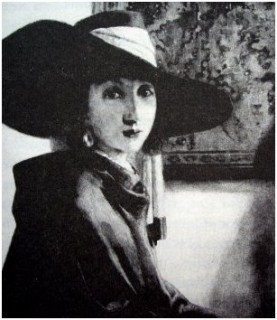Fraud, Interrupted
Having heard Jonathan Lopez speak at the MFA at year or two back, I finally got around to reading his book on Han van Meegeren, The Man Who Made Vermeers.
Fakes are a hobbyhorse of mine; and van Meegeren was astoundingly slick. He had the brass balls to fake Vermeer, the painter of numinous commonplace, of the everyday sublime. And he forged himself. A lifelong crook, he recast himself as the little man who dreamed big, who only wanted to be hailed (to hug himself in modest secret) as the genius that he truly was. A fawning collaborator, filthy rich amid the starving Dutch, who were living by that time on watered tulip-gruel, he became a folk hero, a Robin Hood, to postwar Holland: the man who made a monkey out of Goering. Right in der Führer’s face!
His interrogator so loved the narrative they made together, that all the forger’s war crimes seemed to slip away like last night’s ice. His arrest for the high treason of selling Dutch cultural heritage to the Third Reich turned into a cabaret of a trial for forgery, over which he presided mockingly. Brief triumph: he died a few months later of a syphilitic heart.
This is The Supper at Emmaus that was called “the masterpiece of Johannes Vermeer of Delft”:

Sad, isn’t it? It has all the grace of carved cinderblock, and all the wondrous luminosity of cheap linoleum—which it is, being painted in Bakelite. Great stuff, Bakelite: impervious to all the art-historical tests of his time.
What’s curious about good fakes is that they seem so timeless for a while, then all at once so ludicrously dated. I have seen the “Clara Bow Botticelli” (so named by Kenneth Clarke); sadly, the “Greta Garbo Vermeer” is in limbo.

Some of Vermeer’s earlier late paintings have a kind of louche charm; but deeper in the 30s and 40s, van Meegeren’s puppeting got ugly. Cynically or otherwise, he made Vermeer an Ur-Fascist.
Here is van Meegeren’s Christ and the Adulteress (ca. 1943)—the painting that Goering chose to flee the Allies with, wrapped round a piece of stovepipe: all but last among his spoils:

And here is Hans Schachinger’s Abscheid (1940):

Christ in uniform. Either van Meegeren thought this was truly a holy war, or was pimping cynically to those who did. Either way he’s despicable.
Coolest trivia: van Meergeren’s later Vermeers were painted in Bakelite; John Myatt’s fake Dubuffets were painted with K-Y jelly. Dear art world: Up yours!
Nine
Fakes are a hobbyhorse of mine; and van Meegeren was astoundingly slick. He had the brass balls to fake Vermeer, the painter of numinous commonplace, of the everyday sublime. And he forged himself. A lifelong crook, he recast himself as the little man who dreamed big, who only wanted to be hailed (to hug himself in modest secret) as the genius that he truly was. A fawning collaborator, filthy rich amid the starving Dutch, who were living by that time on watered tulip-gruel, he became a folk hero, a Robin Hood, to postwar Holland: the man who made a monkey out of Goering. Right in der Führer’s face!
His interrogator so loved the narrative they made together, that all the forger’s war crimes seemed to slip away like last night’s ice. His arrest for the high treason of selling Dutch cultural heritage to the Third Reich turned into a cabaret of a trial for forgery, over which he presided mockingly. Brief triumph: he died a few months later of a syphilitic heart.
This is The Supper at Emmaus that was called “the masterpiece of Johannes Vermeer of Delft”:

Sad, isn’t it? It has all the grace of carved cinderblock, and all the wondrous luminosity of cheap linoleum—which it is, being painted in Bakelite. Great stuff, Bakelite: impervious to all the art-historical tests of his time.
What’s curious about good fakes is that they seem so timeless for a while, then all at once so ludicrously dated. I have seen the “Clara Bow Botticelli” (so named by Kenneth Clarke); sadly, the “Greta Garbo Vermeer” is in limbo.

Some of Vermeer’s earlier late paintings have a kind of louche charm; but deeper in the 30s and 40s, van Meegeren’s puppeting got ugly. Cynically or otherwise, he made Vermeer an Ur-Fascist.
Here is van Meegeren’s Christ and the Adulteress (ca. 1943)—the painting that Goering chose to flee the Allies with, wrapped round a piece of stovepipe: all but last among his spoils:

And here is Hans Schachinger’s Abscheid (1940):

Christ in uniform. Either van Meegeren thought this was truly a holy war, or was pimping cynically to those who did. Either way he’s despicable.
Coolest trivia: van Meergeren’s later Vermeers were painted in Bakelite; John Myatt’s fake Dubuffets were painted with K-Y jelly. Dear art world: Up yours!
Nine
Published on June 10, 2011 22:55
No comments have been added yet.
Greer Gilman's Blog
- Greer Gilman's profile
- 42 followers
Greer Gilman isn't a Goodreads Author
(yet),
but they
do have a blog,
so here are some recent posts imported from
their feed.



